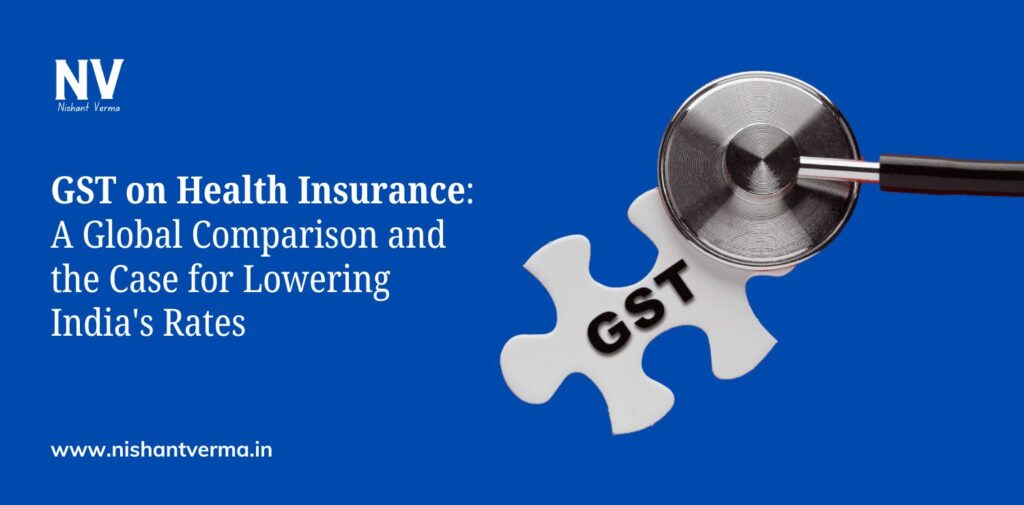The Goods and Services Tax (GST) is a critical component of a nation’s tax system, impacting the pricing of essential goods and services. Health insurance, being a necessity in today’s world, is one such service affected by GST. However, when we compare India’s 18% GST on health insurance premiums to other nations, it becomes evident that the current rate is high and potentially burdensome for the general population.
Countries like Australia, Singapore, the United Kingdom, and the United States have much lower or even zero GST rates on health insurance. In Australia, the GST on health insurance stands at 10%. Singapore levies just 7%, and both the United Kingdom and the United States offer GST exemptions, depending on the state. The disparity in taxation highlights a pressing question for India: Should the GST rate on health insurance be reduced to make healthcare more affordable for its citizens?
Health Insurance: A Necessity, Not a Luxury
In India, health insurance is becoming increasingly important due to the rising cost of medical treatments. A visit to the hospital for even minor treatments can lead to significant expenses. The unpredictable nature of health emergencies further emphasizes the importance of having a robust health insurance plan. Unfortunately, despite being a necessity, health insurance is taxed at a relatively high rate under the current GST structure, making it more expensive for the average citizen.

When we compare this situation with other countries, it becomes apparent that most nations have recognized the essential nature of health insurance and adjusted their tax policies accordingly. For instance, countries like the UK and the US understand the burden that high taxes on essential services like health insurance can place on their populations. As a result, they have exempted these services from GST, making health insurance more accessible.
The Impact of High GST on Health Insurance in India
India’s GST rate on health insurance stands at 18%, one of the highest in the world. This high tax rate not only raises the cost of premiums but also discourages many people from purchasing health insurance in the first place. According to industry experts, the high GST rate is a significant factor in the low penetration of health insurance in India.
When people see the overall cost of health insurance—including the 18% GST—they often hesitate to invest in a policy, especially those from lower-income households who are already grappling with rising living costs. This results in a vicious cycle: fewer people have health insurance, leading to higher out-of-pocket medical expenses, and the healthcare system becomes strained as more people turn to public hospitals for care they cannot afford to pay for privately.

Additionally, the high GST rate on health insurance may undermine the Indian government’s goal of providing universal health coverage. Schemes like Ayushman Bharat aim to make healthcare more accessible to all, but if private health insurance remains taxed at such high levels, it limits the options available to the general population. The government’s efforts to promote health coverage would benefit significantly from lowering the GST rate on health insurance premiums.
Comparing India’s GST Rate with Other Countries
To understand how India’s 18% GST rate on health insurance compares globally, it’s helpful to look at the tax rates in other countries. In Australia, for example, the GST on health insurance is 10%. This rate is almost half of what is levied in India, making health insurance more affordable for Australian citizens. Singapore has an even lower GST rate of 7%, allowing more people to access health insurance without the burden of excessive taxes.
Meanwhile, both the United Kingdom and the United States have opted to exempt health insurance from GST altogether. In the UK, health insurance is classified as a service essential to public welfare, which explains why it is not subject to GST. In the United States, the tax situation varies by state, but many states either exempt health insurance from taxation or impose minimal taxes on it.
The lower tax rates in these countries reflect a policy choice to prioritize healthcare accessibility and affordability. By reducing or eliminating GST on health insurance, these governments acknowledge the vital role that health insurance plays in protecting their populations from financial strain due to medical emergencies.
The Case for Reducing GST on Health Insurance in India
Given the global comparison and the critical role that health insurance plays in ensuring public welfare, it is essential for India to reconsider its current GST rate on health insurance. Lowering the GST could have numerous benefits for both individuals and the healthcare system as a whole.
Firstly, a reduced GST rate would make health insurance more affordable. With lower premiums, more people would be encouraged to purchase insurance policies, resulting in broader health insurance coverage across the country. This would, in turn, lessen the financial burden on individuals and families who face medical emergencies. In a country where out-of-pocket healthcare expenses remain high, improving access to health insurance is crucial.

Secondly, reducing the GST on health insurance could help bridge the gap between urban and rural healthcare. Health insurance penetration is particularly low in rural areas, where healthcare infrastructure is already limited. By lowering the GST on premiums, insurance companies may be more incentivized to offer affordable policies to people in rural areas, thus expanding healthcare access.
Moreover, lowering the GST on health insurance could align with the government’s other policy goals, such as improving public health outcomes and reducing poverty. Health emergencies are one of the leading causes of financial ruin in India. When individuals or families face catastrophic medical expenses without insurance, they are often pushed into poverty. By making health insurance more affordable, the government can play a direct role in preventing this financial collapse for many families.
Lastly, reducing the GST on health insurance would also support the insurance industry, which could then pass on the benefits of lower taxes to consumers in the form of more affordable and comprehensive policies. This would not only help individual consumers but also strengthen the industry overall, leading to more innovation and better services for policyholders.
Conclusion: A Call for Policy Change
In light of these comparisons and the pressing need to make healthcare more affordable, it is clear that the GST rate on health insurance in India should be reduced. The current 18% rate is disproportionately high, especially when compared to countries like Australia, Singapore, the UK, and the US, all of which have recognized the importance of affordable health insurance and adjusted their tax policies accordingly.
India’s high GST on health insurance acts as a barrier to widespread health coverage and financial security for its citizens. By reducing the GST, the government would make a positive step towards improving healthcare access, reducing financial hardship, and supporting the broader goal of universal health coverage.
It is time for policymakers to take a closer look at the burden that the 18% GST on health insurance imposes and consider lowering it to align with global best practices. Health insurance should be a safety net for everyone, not a luxury, and reducing the GST would be a crucial step towards ensuring that all Indians have access to this vital service.




